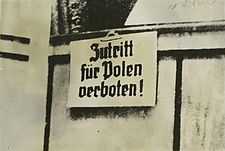
Back المشاعر المعادية لبولندا Arabic Паланафобія Byelorussian Kontraŭpolismo Esperanto Polonophobie French Polonofobija Croatian 反ポーランド感情 Japanese Polonofobi NB Antypolonizm Polish Sentimento antipolonês Portuguese Antipolonism Romanian
| Part of a series on |
| Discrimination |
|---|
 |

Polonophobia,[1] also referred to as anti-Polonism (Polish: Antypolonizm)[2] or anti-Polish sentiment are terms for negative attitudes, prejudices, and actions against Poles as an ethnic group, Poland as their country, and their culture. These include ethnic prejudice against Poles and persons of Polish descent, other forms of discrimination, and mistreatment of Poles and the Polish diaspora.[3]
This prejudice led to mass killings and genocide or it was used to justify atrocities[4][failed verification] both before and during World War II, most notably by the German Nazis and Ukrainian nationalists. While Soviet repressions and massacres of Polish citizens were ideologically motivated, the negative attitude of Soviet authorities to the Polish nation is well-attested.[citation needed]
Nazi Germany killed between 1.8 to 2.7 million ethnic Poles, 140,000 Poles were deported to Auschwitz where at least half of them perished.[5][6]
Anti-Polish sentiment includes stereotyping Poles as unintelligent and aggressive, as thugs, thieves, alcoholics, and anti-Semites.[7][8][9][10][11]

- ^ Ilya Prizel (13 August 1998). National Identity and Foreign Policy: Nationalism and Leadership in Poland, Russia and Ukraine. Cambridge University Press. p. 171. ISBN 978-0-521-57697-0.
- ^ Thaddeus C. Radzilowski,, Anti-Polonism Archived 15 June 2016 at the Wayback Machine
- ^ Rudolf Glanz (1955). "The "Bayer" and the "Pollack" in America". Jewish Social Studies. 17 (1): 27–42. JSTOR 4465299.
- ^ "Deceiving the Public". Retrieved 9 May 2015.
- ^ "Poles — United States Holocaust Memorial Museum". www.ushmm.org.
- ^ Wojciech Materski and Tomasz Szarota. Polska 1939–1945. Straty osobowe i ofiary represji pod dwiema okupacjami. Institute of National Remembrance (IPN), Warszawa 2009, ISBN 978-83-7629-067-6. Page 9
- ^ Johnny McDevitt. "New figures reveal dramatic increase in hate crimes against Polish people". The Guardian. London. Retrieved 20 October 2018.
- ^ "A History of Polish Americans ... Revisited". Cosmopolitanreview.com. 10 February 2009. Archived from the original on 24 April 2012. Retrieved 20 April 2012.
- ^ "Anti-Polish discrimination continues". Ampoleagle.com. Retrieved 20 April 2012.
- ^ Pula, James S. (1996). "Image, Status, Mobility and Integration in American Society: The Polish Experience". Journal of American Ethnic History. 16 (1). University of Illinois Press: 74–95. JSTOR 27502139.
- ^ Scharf, Rafael F. (19 June 2008). "'The two saddest nations on earth': A Polish Jewish octogenarian looks back and forward". East European Jewish Affairs. 31 (1): 95–100. doi:10.1080/13501670108577939. ISSN 1350-1674. S2CID 162660808.
- ^ Sontheimer, Michael (27 May 2011). "Germany's WWII Occupation of Poland: 'When We Finish, Nobody Is Left Alive'". Der Spiegel. Retrieved 26 October 2020.